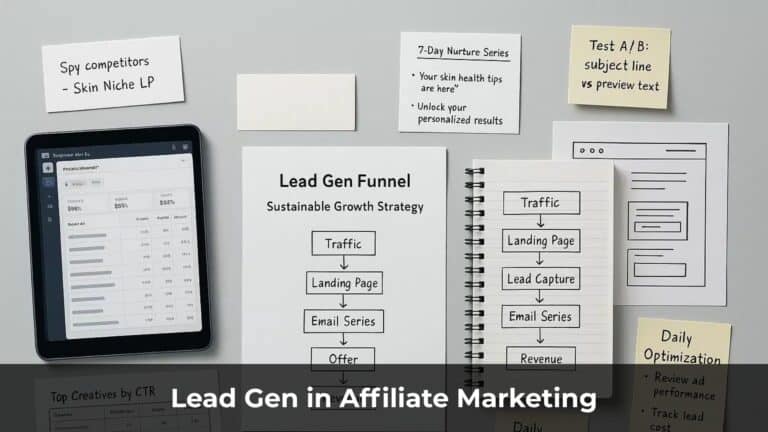When you’re just getting started with affiliate marketing, time is your biggest bottleneck.
Take me, for example. Back then, my daily schedule looked something like this:
- 8 hours of sleep
- 8 hours at work
- 2 hours stuck in traffic
- 3 hours for errands, chores, and daily life
That left me with just 3 to 4 hours a day—at best—to learn and build my affiliate business.
And honestly, that was already a luxury… because I was single and didn’t have kids to take care of.
Tough, right?
Table of Contents
ToggleYou Don’t Have to Do It Alone
Think about it for a second…
While you’re busy dealing with everyday life, a small team could be managing your affiliate campaigns—helping you make money in the background.
I know what you’re probably thinking:
- “But how much is this going to cost?”
- “Shouldn’t I wait until I’m profitable before hiring anyone?”
Here’s something to consider:
If you have some startup capital, hiring help before you’re profitable can actually speed up your results. Especially when you delegate the right tasks to virtual assistants (VAs).
Imagine this: Before you go to bed, you assign a few tasks to your VA—like translating a landing page or setting up tracking links.While you sleep, they get it done. By the time you wake up, everything’s ready. All you need to do is run the ads and drive traffic.
Sounds smart, right?
In this article, I’ll share practical tips for building a lean affiliate team, outsourcing the right way, and scaling your efforts without burning out.

Hiring a Creative Team for Your Affiliate Business
I used to be terrible at Photoshop and video editing. I didn’t know how to code a landing page either.
And unless you went to school for design or computer science, chances are—you’re probably in the same boat.
But here’s the problem:
When you try to do everything yourself—designing your own images, building your own landing pages—you’ll quickly find yourself overwhelmed.You might spend an entire afternoon working… only to end up with a landing page that looks unprofessional and broken.
And guess what? No one buys from a landing page with messy layouts and poor visuals.
If you want to convert visitors into buyers, your landing page needs to look:
- Clean
- Professional
- Persuasive
- Optimized for conversion.
Now, don’t get me wrong—I still encourage you to learn the basics of page building and visual design.
But if you truly don’t have the time, then this is where hiring a virtual assistant (VA) or freelancer makes sense.
There are thousands of talented creatives out there—graphic designers, page builders, editors—who can do these tasks far better and faster than you.
And because many of them live outside the U.S., the cost of hiring them is often surprisingly affordable.
If you want to make money, focus on your strengths. And for the tasks you’re not great at—delegate.
Here are a few creative jobs you can easily outsource:
- Video editing – especially helpful if you’re running video ads on Facebook.
- Banner and image design – essential for high-quality ad creatives.
- Landing page creation – again, make sure it fits your budget before hiring.
If you can do it yourself, that’s great. You’ll need time to learn—but AI tools today can help you get up to speed faster than ever.
But if time is your most limited resource, then outsourcing the creative work is not just smart—it’s necessary.
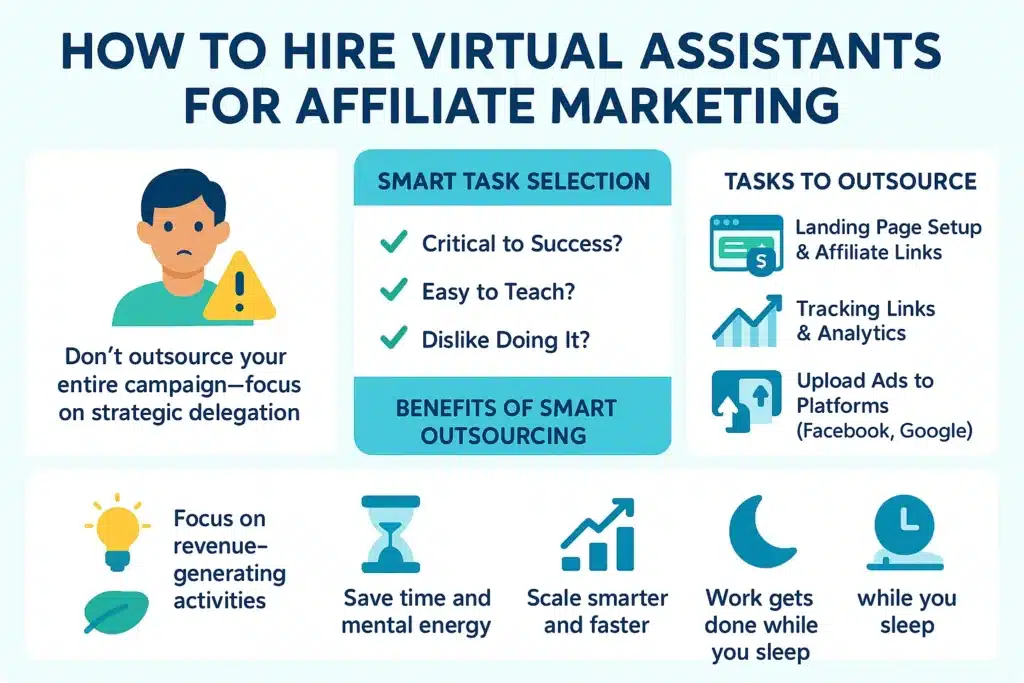
How to Hire Virtual Assistants for Affiliate Marketing
Quick note: Don’t hire a virtual assistant to manage your entire affiliate campaign from start to finish. That’s your job.
If you outsource everything, you’ll miss out on learning the critical skills that actually make you a good affiliate marketer—like copywriting, campaign optimization, and ad creation.
So here’s a smarter approach:
Start by creating a step-by-step plan for your affiliate campaign.List out every task that needs to be completed before launching your ads. Then, for each task, ask yourself:
- Is this task critical to success?
- Is it easy to teach someone else?
- Do I hate doing it—and if so, how much?
Here are a few tasks I do recommend outsourcing:
- Prepping landing pages, tweaking the layout, adding affiliate links
- Setting up tracking links and analytics
- Uploading ad creatives to the traffic source (Facebook, Google, etc.)
Of course, you’ll still need to review the work. But most VAs—if vetted properly—can handle these tasks reliably and efficiently.
And once you trust the process? You can focus on what you do best.
Instead of wasting time and mental energy on things you dislike, you’ll be free to focus on the top 20% of activities that actually generate revenue.
Outsourcing helps you scale smarter.
And the best part? Your virtual assistant can keep working… while you sleep.
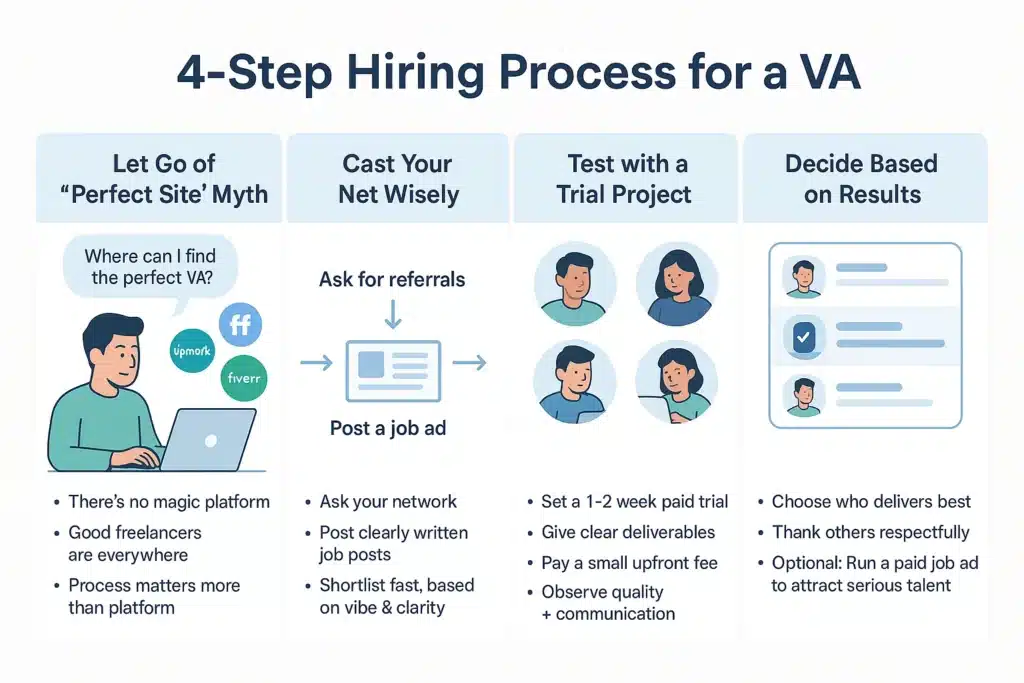
Refine Your Hiring Process Effectively
When people talk about hiring a virtual assistant, the first question is usually:
“What’s the secret website where I can find the perfect VA—skilled, reliable, and affordable?”
Here’s the truth: There is no magic website.
Freelancers are everywhere—from Fiverr to Upwork and beyond. The real secret to building a strong team lies in your hiring process.
Here’s a streamlined system you can follow:
- Ask your affiliate network for trusted recommendations
- Post a job ad on freelance platforms like Upwork or Freelancer
- Do quick interviews with a few promising candidates
- Choose the ones who seem like the best fit
- Pay a small upfront amount to get started and agree on next steps
- Set a trial period (1–2 weeks works well)
- Evaluate their performance based on actual results
- Pick the one who delivers the best work—and move forward
Pro tip: Running a paid job ad on Upwork can help attract serious candidates.
By using this structured approach, you’ll dramatically increase your chances of hiring the right person for your team.
Think in Systems – Build Clear SOPs (Standard Operating Procedures)
One of the most common mistakes beginners make is this: They hire someone… but don’t know how to delegate properly.
They say something vague like, “Can you help me build a landing page?”
And then expect everything to magically fall into place.
But here’s what they forget: Your freelancer isn’t inside your head.
They don’t know the style you want, which tools to use, your deadlines, or even where to send the final files.
So if you want to build a long-term team, don’t just hire people—build systems. You need a clear, repeatable process.For example:
- Create a checklist with step-by-step instructions for launching a campaign
- Record a screen-share video to show exactly how things should be done
- Use a Google Sheet to track progress on each task
It doesn’t have to be fancy. You don’t need a project management degree.
Just a simple, clear SOP that explains what to do, how to do it, and where to update the progress.
Once that’s in place, your team members will know exactly what to do—without constantly asking questions or needing hand-holding.
And every time you onboard a new freelancer? Just send them the SOP. That’s it.
You’ll save dozens of hours every month. And eventually, your operations will run like a well-oiled machine.
That’s the difference between hiring people to lighten your workload…
And hiring people to scale your business.
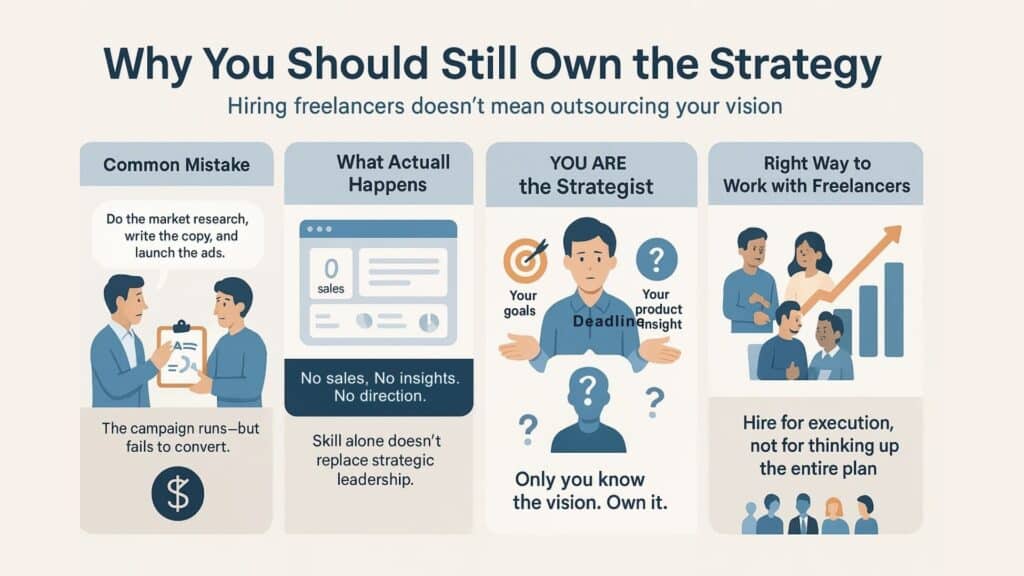
Why You Should Still Own the Strategy
A common mistake among new marketers is this: They finally hire a great freelancer and think, “Awesome, now I can hand off everything from A to Z.”
So they say something like: “Go ahead and do the market research, write the copy, and launch the ads.”
Sounds reasonable, right?
But more often than not, the results fall flat: The campaign runs—but there are no sales. And the data? Useless.
That’s when it hits them: The freelancer might be skilled… But you are still the one who needs to drive the strategy.- You’re the one who understands the goals.
- You know your target market.
- You know the unique strengths of the product you’re promoting.
Without clear direction, even the most talented freelancer can’t deliver meaningful results.
So before hiring anyone, be clear about this: You’re hiring people to help execute your vision— not to create the vision for you.
If you do your part as the strategist, your team will become a powerful asset.
But if you try to completely hand off the thinking and just “hope it works”… You’ll lose money faster than you expect.
Track Performance – Hiring Isn’t the Finish Line
Just because you’ve hired someone doesn’t mean your job is done. Your next task isn’t to relax—it’s to monitor.
Not in a micromanaging way— But to make sure things are actually moving in the right direction.
Because without proper tracking, you won’t know:
- Who’s fast, and who’s lagging behind
- Which tasks are complete, and which ones are overdue
- Who needs extra help, and who’s just… ghosting
A simple way to stay organized is by using a shared Google Sheet: One row per person, one column per task.
When a task is done, they mark it.
If it needs revisions, they leave a comment.
You can also use tools like Notion, Trello, or whatever platform you’re most comfortable with.
No matter what tool you use, the key is to have a system for tracking progress. And you should establish a few basic rules, such as:
- Updates every day—or at least every two days
- Flag any issues early so you can course-correct
- Set clear deadlines—no vague expectations
- Confirm that your freelancer understands the task before they start
Tracking not only helps you stay on top of your projects, It also gives you the data you need to make smarter hiring decisions.
Because let’s face it— Not everyone performs as well as their resume claims.
And without performance data, you won’t know who truly deserves to grow with your team.
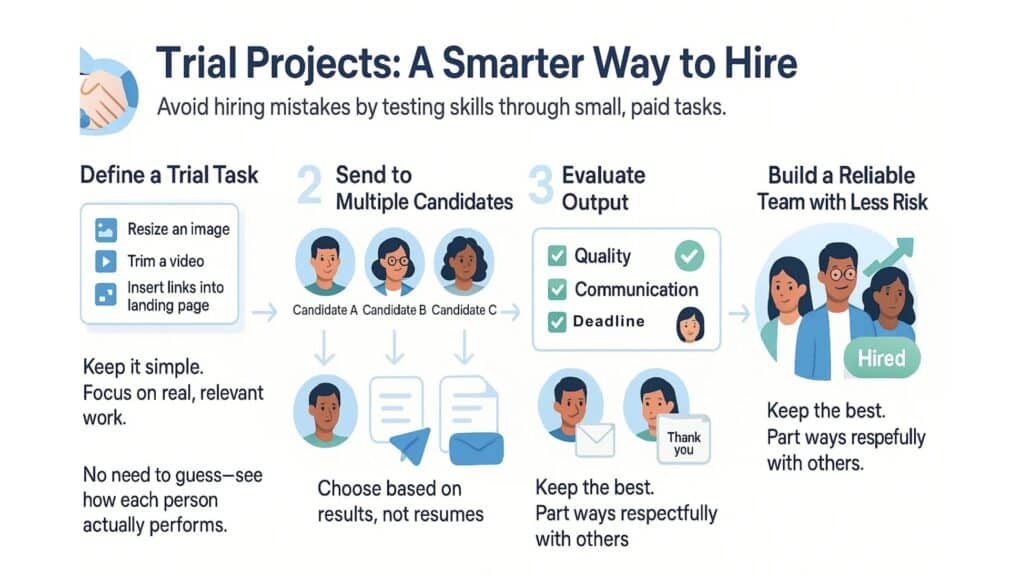
Trial Projects: A Smarter Way to Find the Right People
One of the riskiest hiring mistakes you can make is this: You post a job, review a few resumes, and immediately pick someone to start working.
The problem?
A resume might look impressive. A portfolio might seem polished. But once real work begins, things often don’t go as expected.
A better strategy is to run paid trial projects.
You don’t need a huge budget. Just break the work into smaller tasks, and let a few candidates complete a portion.
Trial hiring helps you:
- Compare speed and output quality across candidates
- Evaluate work ethic and communication style
- Identify who’s actually a good long-term fit
You can prepare a simple test task, such as:
- An image that needs editing
- A short video clip to cut and trim
- A landing page that needs minor code tweaks and link insertion
Nothing too complex—just enough to see their real-world skills and initiative.
Once the trial period ends, you keep the best performer and politely thank the others for their time.
By doing this, you’ll avoid costly hiring mistakes down the road— And most importantly, you’ll start building a truly reliable and high-quality team.
Why Building a Team Is the Key to Scaling
Many people think hiring a team is just about making life easier. But if that’s your only goal, you might be missing a much bigger opportunity.
Building a team doesn’t just save you time— It helps you break free from the trap of “trading time for money.”
There’s only so much you can do alone in a single day. But with even just 1 or 2 people supporting you, your output can easily double or triple.
When you focus on strategy—and your team handles the execution— You’ll be able to launch more campaigns, test ideas faster, and optimize more efficiently.
Most importantly, building a team early forces you to think like an owner.
You’re no longer the person who does everything— You become the one who leads, delegates, and builds systems.
Affiliate marketing, at its core, is a scalable business model.
And your team is the key to unlocking that scalability.
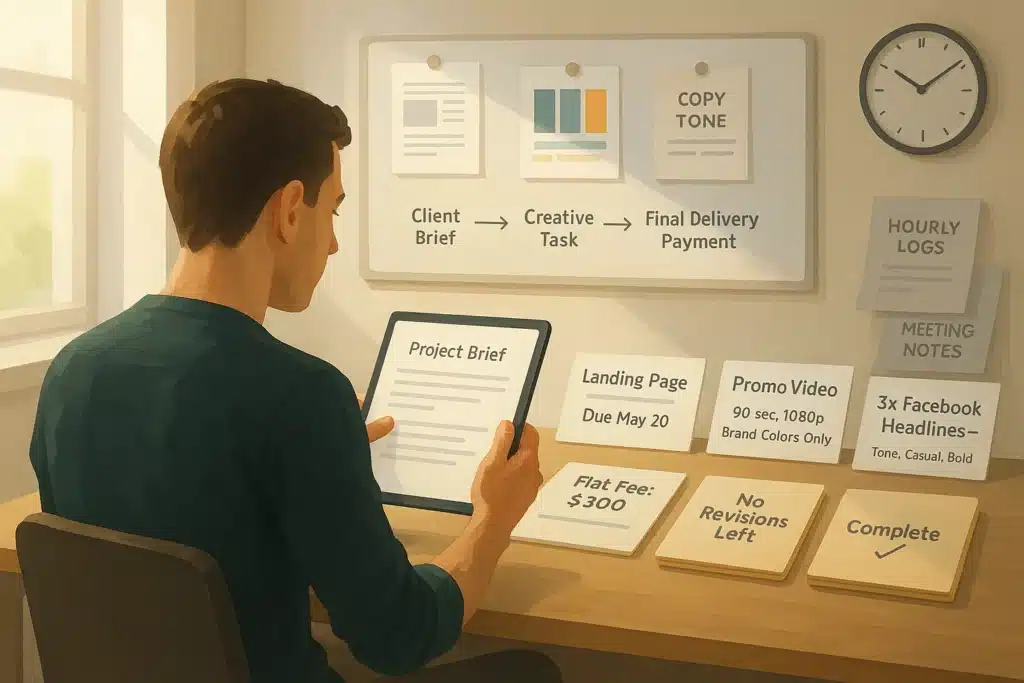
When to Use Flat-Rate Projects in Affiliate Marketing
Not every task in affiliate marketing should be billed by the hour. In many cases, a flat-rate, project-based approach is far more efficient.
Instead of tracking time, you assign a specific deliverable— For example:
- Designing a landing page
- Creating a promo video
- Writing three Facebook ad variations
Then, you agree on a fixed fee for the entire job. No hourly tracking. No daily check-ins. Just clear deliverables—and payment for results.
This method works best when the outcome is well-defined, the task doesn’t require constant feedback, and the freelancer can simply deliver the final product.
But if you go this route, clarity is everything.
Be sure to clearly outline your expectations from the start:
- Technical requirements
- Design style or brand tone
- Image dimensions
- Video length
- Any other criteria that matter
If possible, include reference samples to give them a better sense of what you’re aiming for.
Also, don’t forget to establish a few basic terms:
- Delivery deadline
- Number of allowed revisions
- Payment structure (e.g. 50% upfront, 50% upon completion)
Of course, project-based work isn’t ideal for every task.
For jobs that require frequent adjustments or close collaboration across a team, hourly or retainer-based models may be better.
But when you choose the right task—and provide clear instructions— flat-rate contracts can save you time, reduce complexity, and maintain quality.
Use Time-Tracking Tools to Manage Remote Work Effectively
When you hire remote workers—especially on an hourly basis—tracking their working time becomes essential.
One powerful tool that can help with this is DeskTime.
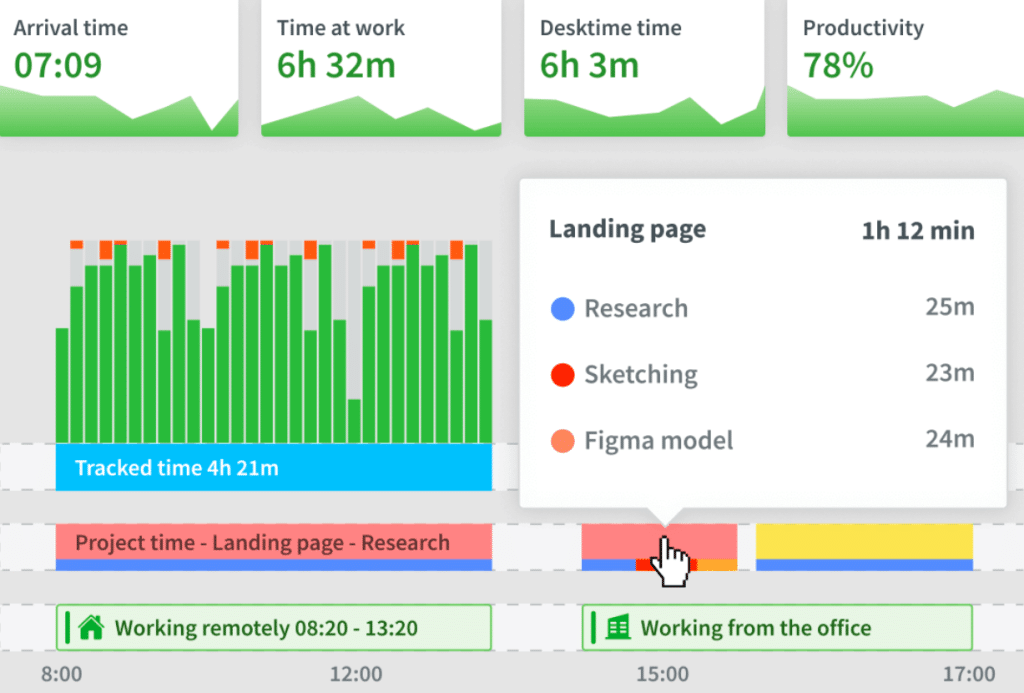
This software allows you to:
- Track total working hours each day
- Measure employee focus based on the apps they use and websites they visit
- And most notably: automatically capture screenshots at random intervals (typically every 5 minutes)
The goal of screenshot monitoring isn’t to micromanage— It’s simply to ensure that the person is actually working, not just leaving a timer running in the background.
That said, transparency matters.
Be sure to inform your team in advance if you plan to use a time-tracking tool like DeskTime. This builds trust and sets the right expectations.
When used properly, time-tracking software doesn’t just help you manage productivity— It also encourages your team to build better, more consistent work habits.
Final Thoughts…
If you’re a busy professional working a full-time job, chances are you only have 2 to 3 hours a day to build your affiliate business.
But here’s the good news:
When you know how to delegate, you can get more done—and get it done better—than if you tried to do everything yourself.
Outsourcing helps you move faster toward your goals. If you insist on doing it all alone, you might actually be holding yourself back.
- You don’t need to be a one-person army.
- You don’t need to burn yourself out trying to “do it all.”
That approach might work for 22-year-olds with endless energy— But for the rest of us, building smart systems and working with a team is the real game-changer.
So start simple:
Build a hiring process.
Find a few candidates.
And take the first step toward scaling your affiliate business the smart way.
Ready to build your first affiliate team? Start small—but start today.


